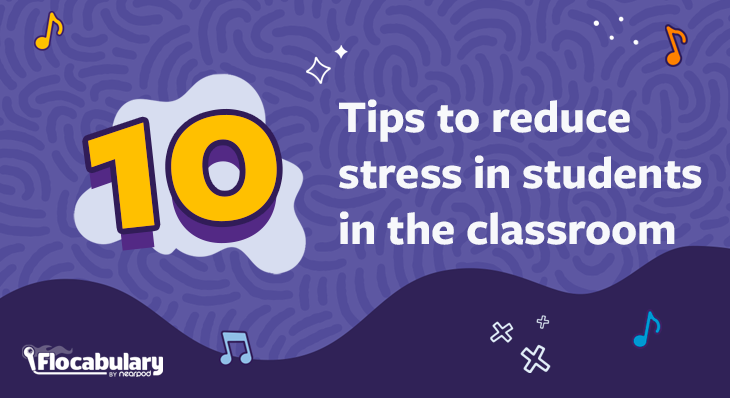
10 Tips to help students reduce stress in the classroom
Students at all levels are learning to balance schoolwork, extracurricular activities, relationships, and mental health. When it comes to a slew of testing, including standardized state tests and AP exams, navigating all of these pressures is its own challenge. This is why stress management techniques for students are crucial, as they provide essential coping mechanisms to navigate through challenging academic demands and maintain mental well-being through pressures that can otherwise feel overwhelming.
The pandemic has also affected students’ mental health. According to Education Week, eighteen percent to as much as 60 percent of children and adolescents across the board had strong “distress,” especially symptoms of anxiety and depression, which affected more than 1 in 4 adolescents in some countries. It’s important to help reduce stress in students and prioritize social and emotional learning in the classroom.
What are stress management strategies for students?
Heidi Grant Halvorson’s Nine Ways Successful People Defeat Stress can be used for students (and teachers!) in the classroom. Halvorson writes for adults in the workplace, but the basic tenets she presents are invaluable for students as well. Keep reading to explore Halvorson’s 9 stress-defeating tips and our suggestions for implementing them at the student level with Flocabulary. Whether you teach elementary, middle school, or high school students, these tips will help them deal with stress properly.
The power of Flocabulary
Flocabulary’s educational video lessons create emotional connections by harnessing the power of music, as well as visual art, storytelling, humor, drama, and poetry. Rigorous and standards-aligned, these video-based lessons with activities support vocabulary acquisition and comprehension skills across K-12 subjects. Each video-based lesson includes a suite of instructional activities that provide additional practice and exposure at varying levels of rigor to scaffold instruction.
Here’s an example of the type of engaging videos you can find on Flocabulary!
Captivate students and make learning experiences memorable and interesting through Flocabulary. Teachers can sign up below to access video lessons and activities shared in this blog post. Administrators can contact us below to learn more about the power of Flocabulary Plus.
9 Tips to reduce stress in students in the classroom
1. Encourage self-compassion
“Most of us believe that we need to be hard on ourselves to perform at our best, but it turns out that’s 100 percent wrong,” writes Halvorson. While discipline and drive are vital components to academic success, it’s also important to remind students to be kind to themselves. Everyone fails at something at some point, and that’s okay. Help students understand that being hard on themselves about a bad test score or a forgotten homework assignment is a waste of valuable energy. Instead, encourage them to take a breath, forgive themselves, learn from their mistake, and set off to conquer the next assignment with renewed zeal.
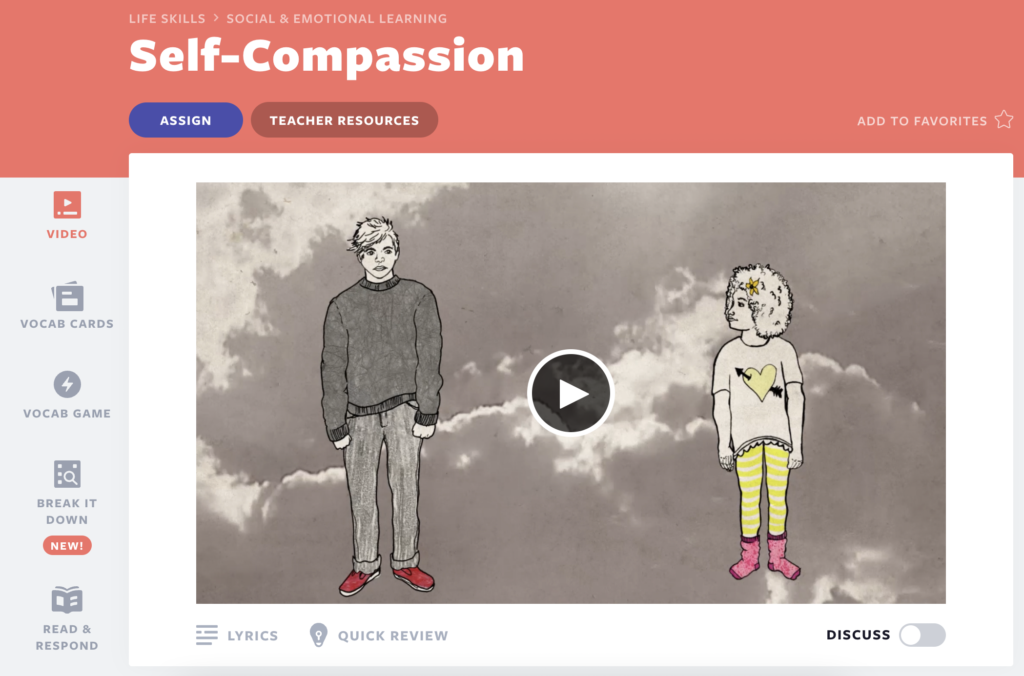
Flocabulary’s Self-Compassion video lesson is about respecting, loving, and accepting yourself! Self-compassion has been shown to decrease stress, boost happiness, improve body image, and reduce the risk of depression and anxiety. Students will learn self-compassion and discover actionable strategies to help cultivate it within themselves. When addressing stress management for students, remind them that letting go of mistakes helps reduce anxiety and leads to more success in the long run!
2. Focus on the “Big Picture” to manage stress
When a single task on your student’s to-do list is increasing stress levels, for example, completing 20 math problems or writing an essay, suggest they try reframing the task in terms of a bigger goal. Maybe “completing 20 math problems” or “writing an essay” could be “practice for the next exam,” “a chance to raise my grade,” “a higher grade point average,” and even, eventually, “more options for applying to college.” For teachers, maybe “grading 30 essays” could be “helping my students succeed.” Menial tasks can be irksome and difficult, especially for students who often have work to do in a subject they don’t think is valuable. If a task feels worthless, students can try reframing it in terms of goals they really care about: “graduating,” “getting into my dream school,” or even “not having to go to summer school.”
3. Emphasize the importance of routines
Making a decision, even about something as small as what to eat for lunch or what shirt to wear, can be a stressful process. It turns out routines can help us eliminate excess hemming and hawing, and extra stress, from our days. Encouraging students to do things at the same time every day can help them reduce stress levels. It’s not easy, but always doing homework at a certain time and, dare we say it, going to bed at a specific hour can give students more time and head space during the evening to relax and recharge. Finding a solid routine takes trial and error, but most importantly, self-compassion (referring back to tip #1!). It’s important to remind students to be kind to themselves as they take on a new routine. Encourage them to try new routines that reduce student stress such as regular exercise, meditation, or journaling. Also, time management and managing stress go hand in hand as it can feel overwhelming when deadlines loom large and tasks pile up without a clear plan in place.
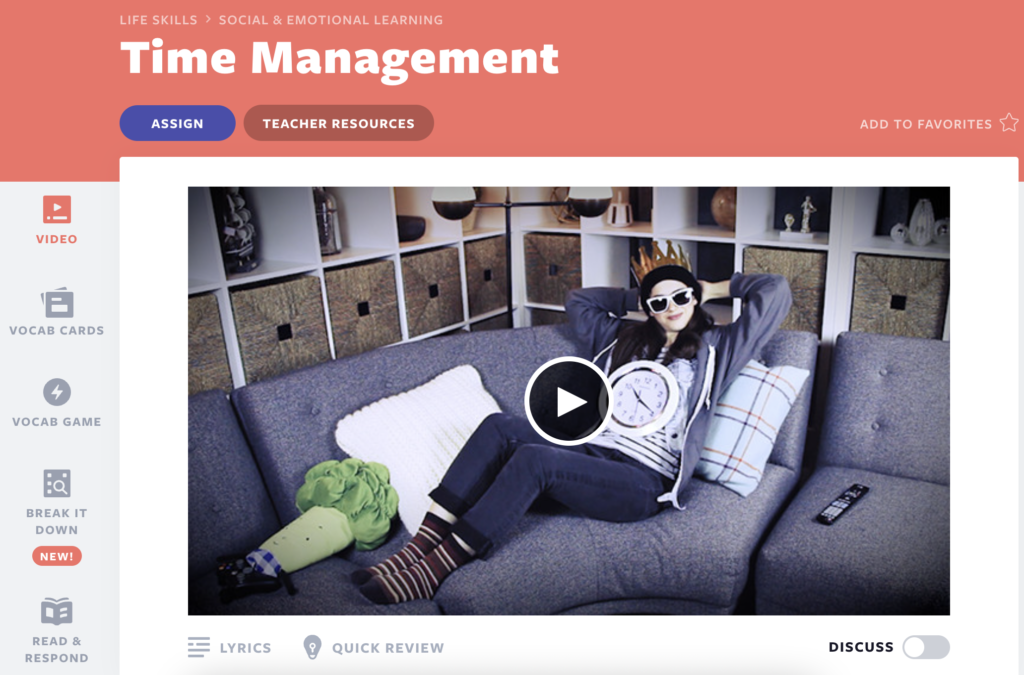
Flocabulary’s Time Management video lesson teaches students about planning and exercising control over the amount of time they spend on specific activities. It will help them manage the rest of their day, whether they need to study, practice a sport, see a friend, or do their chores.
4. Inspire students to do something they find interesting for 5-10 minutes
Hopefully, we are all taking the time to do things we find interesting. But students might be more inclined to set aside those 5-10 minute windows when they learn that it will actually help replenish their energy.
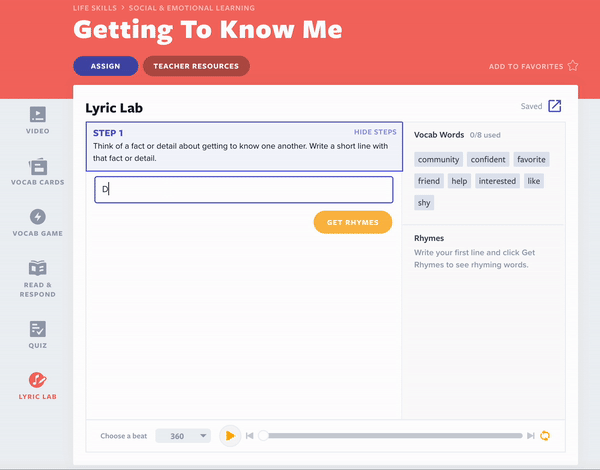
In fact, if you find this interesting, set aside time today to read the research that backs it up. Remember that “interesting” by these standards implies “increased motivation, effort, attention, and persistence,” i.e., their favorite TV show is unlikely to qualify. But if they opt to, say, build a Lego fortress or do a Sudoku puzzle, you are likely to find you have extra energy than you had to begin with. Encourage your students to do something challenging and fun for a few minutes daily. Learn to juggle! Teach the dog a new trick! Paint with watercolors! Write a rap song using Lyric Lab! The possibilities are endless.
5. Where and when should be on their to-do list
Do you wish you could trick your brain into nudging you to complete tasks on your to-do list? Psychologists have discovered that you can by using “if-then” statements. Much like relying on routines, this is a great tip for students who procrastinate or have trouble getting motivated to start their homework each night. Rather than putting “do homework” on a checklist, they can write, “If it is 4pm, then I will do my homework.” Sounds silly, but according to Halvorson, this “can double or triple your chances of actually doing it.” Like it or not, your brain will start unconsciously looking for clues that it’s time to get cracking on that essay or math problem.
6. Use “if-then” statements for positive self-talk
The power of the if-then statement continues if it’s used to target common stress triggers. You can encourage older students to identify the thing that stresses them out the most and then create an “if-then” statement about how they would like to react. “If I don’t do well on this exam, I will stay calm and focus on preparing for the next one.” “If I lose a game, I will take a deep breath and relax.” “If I get frustrated with an assignment, then I will take a break and come back to it.” Although it sounds easier said than done, setting an intention for what will be accomplished or how they will react creates an opportunity for students to make choices that support their goals.
If your students need support identifying goals, Flocabulary’s Goal Setting video lesson teaches criteria for setting and reaching goals using the SMART acronym. Students learn to set goals that are specific, measurable, actionable, realistic, and time-based.
7. Remind them it’s progress, not perfection
Halvorson identifies two mindsets we all use to approach goals: “the Be-Good mindset,” which is based on proving that you already excel, and the “Get-Better mindset,” which focuses on developing and learning so that you will excel. “You can think of it as the difference between wanting to show that you are smart versus wanting to get smarter,” she writes.
When we approach things through the “Be-Good” mindset, we expect ourselves to be totally perfect, especially compared to everyone else. If things don’t go according to plan, we start to doubt ourselves, which makes us less likely to ultimately succeed.
The “Get-Better” outlook encourages self-comparison instead of comparison with peers and emphasizes making progress. Again, this approach asks that we be kind to ourselves: expect mistakes and let them go. We can encourage students to evaluate their own progress. Instead of “I failed because I got a B and he got an A,” try, “I succeeded because I got a B- on the last essay and a B on this one. I’m getting better.” Getting adolescents not to compare themselves to their peers is impossible, but we can remind them that they are improving and that we notice, and that making progress, instead of being perfect, is the goal.
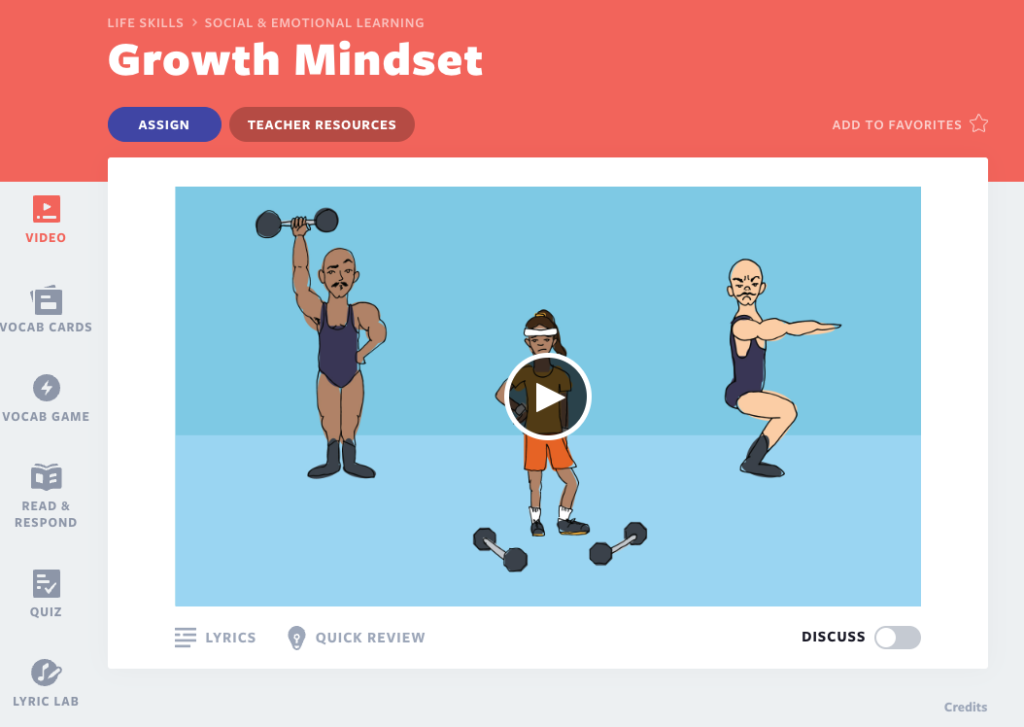
Flocabulary’s Growth Mindset video lesson teaches students that if they want to improve in any part of their life, they need to know the value of making mistakes, working hard, and believing that they can do anything. Making mistakes can be frustrating, but you can learn from them. Intelligence isn’t fixed; it’s malleable! When you have that attitude, you have a growth mindset.
8. Notice the small wins and encourage celebration
Instead of focusing on how much we have left to do, we can pat ourselves on the back for everything we’ve done so far. Having 11 chapters left to read is pretty dismal — but having 5 already read is pretty great! Focusing on small wins can give students the mojo they need to keep moving toward a larger goal. Help reinforce small wins for individuals, like completing an outline for an essay, or for entire classes, stating to them, “Together we got through 50 years of US History!”
9. Understand which mindset works best for your students
Everyone has his or her own motivational style. “Reaching for the stars” isn’t for everyone. Some people are just as effectively motivated by keeping their heads above water. Recognize that an optimistic eagerness to succeed isn’t necessarily less healthy or powerful than Halvorson describes as “hearty skepticism.” Focusing on preventing failure is a better approach for some. What’s important is that each student figures out what works for them.
10. BONUS TIP: Create mindful moments in your classroom to reduce stress in students
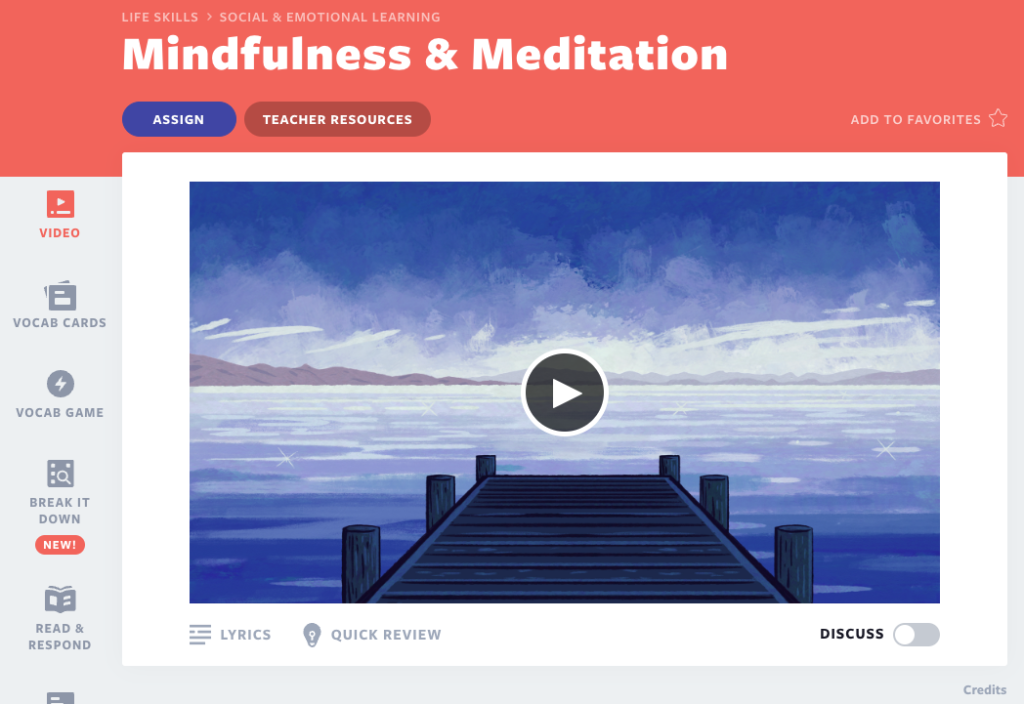
Mindfulness is a practice and state of mind that involves noticing your thoughts and bodily sensations. Meditation can help students increase focus and avoid conflict when managing stress. Teachers can carve out time for practicing mindfulness, such as 5-10 minutes daily, or build a routine for “Mindful Monday,” where students can learn these skills and implement them into their daily lives to reduce stress.
This Flocabulary video offers ways to incorporate mindfulness and meditation in the classroom. The video ends with a short meditation by the artistic-wellness movement Kinetic Vibez. Use this resource as a physical activity for students to improve their stress responses and mental health through deep breathing. Watch the video on YouTube!
Use Flocabulary’s video lessons to teach life skills and more
We hope Halvorson’s tips inspire you to take deep breaths and address your stress. Encourage your students to start learning how to manage stress early. Every type of stress is a part of life, and even though “finding balance in the face of stress” won’t be a topic on any of the standardized tests this spring, it is one of the most important lessons students can take with them through their academic years. In fact, it can have a lasting impact on their academic performance and well-being.
Captivate students and make learning experiences memorable and interesting through Flocabulary. Teachers can sign up below to access video lessons and activities shared in this blog post. Administrators can contact us below to learn more about the power of Flocabulary Plus.
